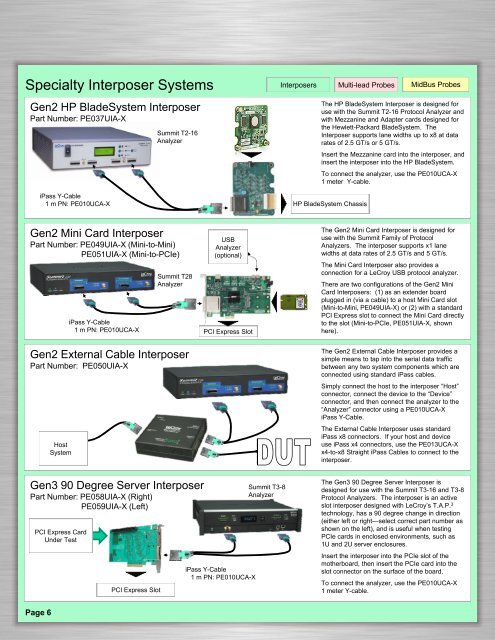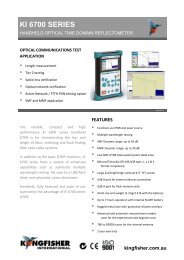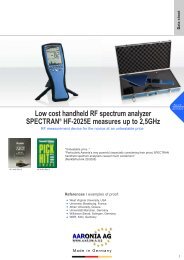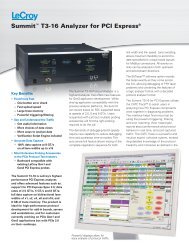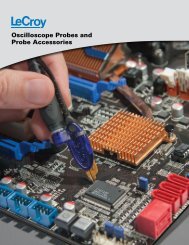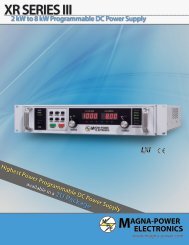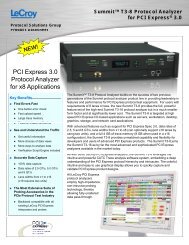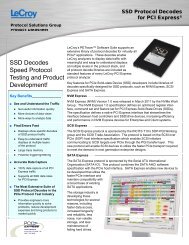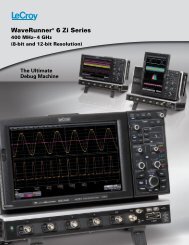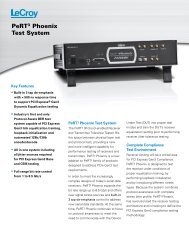Interposers and Probes Datasheet - Teledyne LeCroy
Interposers and Probes Datasheet - Teledyne LeCroy
Interposers and Probes Datasheet - Teledyne LeCroy
Create successful ePaper yourself
Turn your PDF publications into a flip-book with our unique Google optimized e-Paper software.
Specialty Interposer Systems<br />
Gen2 HP BladeSystem Interposer<br />
Part Number: PE037UIA-X<br />
Summit T2-16<br />
Analyzer<br />
<strong>Interposers</strong><br />
Multi-lead <strong>Probes</strong><br />
MidBus <strong>Probes</strong><br />
The HP BladeSystem Interposer is designed for<br />
use with the Summit T2-16 Protocol Analyzer <strong>and</strong><br />
with Mezzanine <strong>and</strong> Adapter cards designed for<br />
the Hewlett-Packard BladeSystem. The<br />
Interposer supports lane widths up to x8 at data<br />
rates of 2.5 GT/s or 5 GT/s.<br />
Insert the Mezzanine card into the interposer, <strong>and</strong><br />
insert the interposer into the HP BladeSystem.<br />
To connect the analyzer, use the PE010UCA-X<br />
1 meter Y-cable.<br />
iPass Y-Cable<br />
1 m PN: PE010UCA-X HP BladeSystem Chassis<br />
Gen2 Mini Card Interposer<br />
Part Number: PE049UIA-X (Mini-to-Mini)<br />
PE051UIA-X (Mini-to-PCIe)<br />
Summit T28<br />
Analyzer<br />
USB<br />
Analyzer<br />
(optional)<br />
iPass Y-Cable<br />
1 m PN: PE010UCA-X PCI Express Slot<br />
Gen2 External Cable Interposer<br />
Part Number: PE050UIA-X<br />
Host<br />
System<br />
The Gen2 Mini Card Interposer is designed for<br />
use with the Summit Family of Protocol<br />
Analyzers. The interposer supports x1 lane<br />
widths at data rates of 2.5 GT/s <strong>and</strong> 5 GT/s.<br />
The Mini Card Interposer also provides a<br />
connection for a <strong>LeCroy</strong> USB protocol analyzer.<br />
There are two configurations of the Gen2 Mini<br />
Card <strong>Interposers</strong>: (1) as an extender board<br />
plugged in (via a cable) to a host Mini Card slot<br />
(Mini-to-Mini, PE049UIA-X) or (2) with a st<strong>and</strong>ard<br />
PCI Express slot to connect the Mini Card directly<br />
to the slot (Mini-to-PCIe, PE051UIA-X, shown<br />
here).<br />
The Gen2 External Cable Interposer provides a<br />
simple means to tap into the serial data traffic<br />
between any two system components which are<br />
connected using st<strong>and</strong>ard iPass cables.<br />
Simply connect the host to the interposer “Host”<br />
connector, connect the device to the “Device”<br />
connector, <strong>and</strong> then connect the analyzer to the<br />
“Analyzer” connector using a PE010UCA-X<br />
iPass Y-Cable.<br />
The External Cable Interposer uses st<strong>and</strong>ard<br />
iPass x8 connectors. If your host <strong>and</strong> device<br />
use iPass x4 connectors, use the PE013UCA-X<br />
x4-to-x8 Straight iPass Cables to connect to the<br />
interposer.<br />
Gen3 90 Degree Server Interposer<br />
Part Number: PE058UIA-X (Right)<br />
PE059UIA-X (Left)<br />
PCI Express Card<br />
Under Test<br />
PCI Express Slot<br />
iPass Y-Cable<br />
1 m PN: PE010UCA-X<br />
Summit T3-8<br />
Analyzer<br />
The Gen3 90 Degree Server Interposer is<br />
designed for use with the Summit T3-16 <strong>and</strong> T3-8<br />
Protocol Analyzers. The interposer is an active<br />
slot interposer designed with <strong>LeCroy</strong>’s T.A.P. 3<br />
technology, has a 90 degree change in direction<br />
(either left or right—select correct part number as<br />
shown on the left), <strong>and</strong> is useful when testing<br />
PCIe cards in enclosed environments, such as<br />
1U <strong>and</strong> 2U server enclosures.<br />
Insert the interposer into the PCIe slot of the<br />
motherboard, then insert the PCIe card into the<br />
slot connector on the surface of the board.<br />
To connect the analyzer, use the PE010UCA-X<br />
1 meter Y-cable.<br />
Page 6


